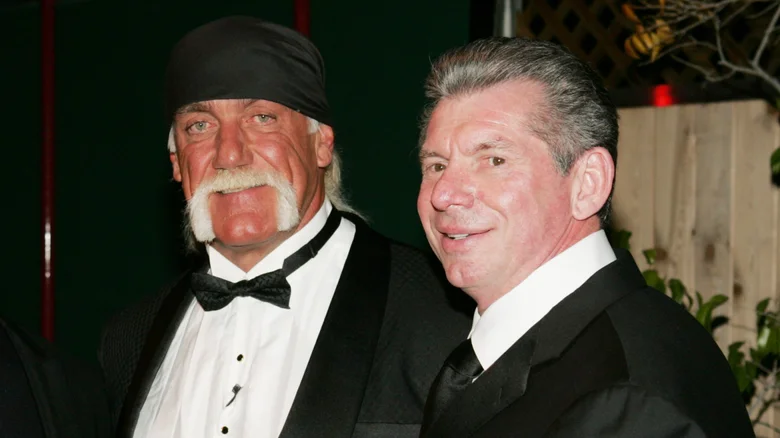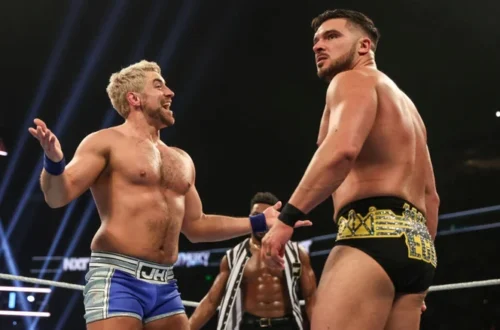The wrestling world gathered in Florida this summer to say goodbye to Hulk Hogan, a figure who helped shape an era of sports entertainment and pop culture. The private memorial brought out a long list of stars, friends, and family. It also delivered one of the most talked about moments of the year when Vince McMahon stepped to the podium and delivered a surprise eulogy. Weeks later Jeff Jarrett spoke about the service and about Vince’s tribute, giving fans a rare look at what happened inside the room and how it felt to those who were there.
Before we get to Jarrett’s take, it is important to set the scene. Hulk Hogan, born Terry Bollea, passed away at the age of seventy one on July twenty four in Clearwater after suffering a cardiac arrest. A Florida medical examiner later listed the cause as a heart attack and classified the death as natural. The news drew statements from across wrestling and beyond, and tributes poured in from peers and rivals who had known Hogan for decades.

Vince McMahon, the promoter who helped launch Hulkamania nationwide in the nineteen eighties, posted a public message on social media the day Hogan died. In it he called Hogan the greatest WWE Superstar of all time, praised his drive, and thanked him for giving everything to the audience. That message set the tone for what would later be a much more personal moment at the memorial itself.
Before the memorial
The invitation only celebration of life was planned in Clearwater with heavy security and a guest list that felt like a wrestling reunion. Family attended, as did friends from inside and outside the business. Names reported at or around the service included Ric Flair, Kevin Nash, Kid Rock, Theo Von, and several McMahon family members along with Paul Levesque. The event was kept private, and only a few details surfaced in the days that followed, which is why first person recollections from attendees have carried so much weight.
Jeff Jarrett, a WWE Hall of Famer and a veteran promoter and executive, was one of those attendees. On his podcast he later reflected on what he saw and heard. Jarrett said it was a very private gathering, that Vince McMahon and Paul Levesque spoke, and that the pastor’s message about Hogan’s faith journey and mindset in the last two to three years moved him deeply. He described leaning over to his wife Karen during the sermon and saying he felt grateful to have been there to hear it. Jarrett stressed that the message was not for clicks and not a hype segment. It was a heartfelt tribute delivered in a room of people who loved the man.
During the memorial
Vince McMahon’s appearance was the surprise of the day. Reports from wrestling media described Vince making a brief entrance for his eulogy, giving a tribute that ended with a request for everyone to stand and deliver one last ovation for The Hulkster. One account compared the cameo to the Wizard of Oz since he appeared for his speech and disappeared soon after. Another outlet echoed the standing ovation detail and noted the presence of a who’s who audience that included stars from multiple generations.
Those details match with Jarrett’s framing of the day. His recollection placed McMahon’s remarks alongside Levesque’s and the pastor’s message as the key speaking moments. Jarrett did not disclose every word of the eulogy, and given the private nature of the event, that restraint makes sense. But the picture that emerges is a room asked to celebrate as well as mourn, with Vince offering a send off that invited people to cheer one more time for the icon he helped create.
From a historical standpoint that moment felt full circle. Vince and Hogan soared together in the boom years of the eighties, drifted apart during mid nineties turmoil, and reunited on and off in the two thousands. The public tribute Vince posted on the day of Hogan’s passing called him the greatest and praised his connection to the fans. The memorial eulogy, as described by those present, brought that praise into a personal space and asked the room to share in one final thank you to the man who told generations to train, say their prayers, and take their vitamins.
Jarrett’s comments and why they matter
Jarrett’s words about the service spoke to two themes. First, the blurring of public and private when a global celebrity passes away. Second, how the pastor’s testimony centered the man behind the character. Jarrett said the sermon captured Hogan’s outlook during his last couple of years and that it was powerful to hear that message in a room where everyone knew the person, not just the performer. He sounded grateful and thoughtful rather than sensational, which lends credibility to his account. He also confirmed that Vince and Levesque did speak, which adds to the developing record of who addressed the mourners.
Jarrett has a unique vantage point. He worked with Hogan in different chapters, including the TNA years and various crossovers. He also lived the promoter’s life, learned from his father Jerry Jarrett, and has seen how memorials can become public arenas by accident. When he praises the private tone of the pastor’s message and calls it something the whole world should hear, he is not trying to turn a funeral into content. He is highlighting the rare moment when a room full of wrestlers and family listened to a story about faith, gratitude, and personal change. That shapes how we read the Vince eulogy too, because it suggests the tribute fit a room that wanted closure and joy, not spectacle.
Reactions across the community
Fans responded to the reports in a variety of ways. On social media, many praised the idea of one last ovation and said it felt right for a figure who spent his life playing to the crowd. Others voiced discomfort given Hogan’s controversies and the complicated legacy that follows him, while still acknowledging his impact on the industry. That split echoed the broader media coverage that balanced celebration with context about Hogan’s public life.
Industry reporters focused on the symbolism of Vince returning to speak. News pieces detailed his public statement on the day of Hogan’s passing and then connected it to the eulogy at the memorial. Analysts pointed out that whatever one thinks about either man, the two have been linked since the first WrestleMania, and that it made sense for Vince to offer a final tribute. The gesture of asking for a standing ovation was widely reported and became the defining image from the service.
After the memorial
In the weeks after the service, Jarrett’s reflections gave fans a way to process the day without breaking the privacy of the room. He stressed the emotion of the pastor’s words and confirmed that the key voices from WWE history spoke in tribute. Media outlets continued to fill in details, from the cause of death reported by officials to the list of notable attendees who paid respects in Clearwater. The result is a clearer timeline of what happened and why it mattered to so many people in and around wrestling.
The service also placed a focus on legacy. Hogan was a two time WWE Hall of Famer, a star who headlined and anchored major moments across decades. He also lived through serious controversies and health challenges. The accounts from the memorial do not ignore that baggage, but they focus on gratitude, on faith in later life, and on a communal farewell. Jarrett’s account of the pastor’s message helps explain why the room left with a sense of peace rather than a cloud of tabloid noise.
What Jarrett’s perspective tells us about Vince’s eulogy
Jarrett did not try to grade Vince’s speech, but he did frame it alongside the other parts of the service. He presented it as one piece of a larger program that included Levesque and the pastor, with Vince’s role to call for a final celebration. Reports of that standing ovation and the quick exit match the notion of a cameo done for respect rather than attention. It reads like a nod from the promoter who knew better than anyone how much the roar of a crowd meant to Hogan.
It is also striking that Jarrett made a point to talk about the pastor’s words in such detail. That emphasis suggests the eulogy worked because it sat inside a service that was bigger than any one speaker. People gathered to grieve and to celebrate. The pastor told them what the last years looked like from a spiritual view. Vince asked them to cheer one more time. Together those moments became a shared memory the room could carry out into the world. Jarrett’s comments give that memory shape for fans who were not inside.
Expert view and context
From an industry historian’s lens, Vince eulogizing Hogan carries deep symbolism. These two names built the national wrestling boom in the eighties, navigated legal storms and creative wars in the nineties, and reconnected in the two thousands as nostalgia became a major driver of WWE programming. Vince’s public statement called Hogan the greatest and emphasized his bond with fans. The memorial scene of a standing ovation aligns with that message and closes the circle on a relationship that shaped the business more than any other promoter performer pairing of its time.
It also underlines how memorials for wrestling legends differ from most public figures. The audience does not only remember songs or films. They remember shared chants, poses, finishers, and catchphrases. By asking mourners to stand and applaud, Vince gave a wrestling crowd a ritual that felt authentic to Hogan’s story. Jarrett’s approval of the room’s tone suggests the choice landed the right way for those who mattered most that day.
What happens next
In terms of programming, fans can expect continued tributes across archival content and documentaries. Vince’s statement and the memorial coverage have already been cited by outlets recounting Hogan’s career and influence. You will likely see more long form pieces that revisit his peaks, his controversies, and his complicated legacy, especially as anniversary dates arrive. Jarrett’s praise for the pastor’s message may also encourage future projects to spend more time on Hogan’s later life and personal growth rather than only retelling the eighties playbook.
For Jarrett himself, his comments remind listeners why his voice has value in moments like this. He has wrestled, promoted, and managed talent across multiple eras. He has history with Hogan, both smooth and rocky. When he says the service felt special and that the pastor’s words were worth hearing, it helps fans understand why the people in that room seemed at peace. It also helps settle debate over whether Vince should have spoken at all. Based on Jarrett’s account and the reports of the standing ovation, it sounds like the answer in that room was yes.
Final word
Jeff Jarrett’s reflections on Vince McMahon’s eulogy provide a grounded, human view of a private farewell. They do not spoil the intimacy of the memorial, but they confirm that Vince, Levesque, and the pastor honored Hulk Hogan in a way that mixed grief with celebration. The reports of a final ovation and a swift exit add a splash of showmanship that still felt respectful. Jarrett’s account of the pastor’s testimony adds the heart. Together they paint a complete picture of a day when the industry came together not for a spectacle, but for a goodbye. And in that goodbye, you can hear the echo of the message that carried Hogan through arenas for decades. Say your prayers. Take your vitamins. Believe in the roar of the crowd.

![Logan Paul joined forces with The Vision. [Image via WWE.com]](https://watchwrestlingin.online/wp-content/uploads/2025/11/Logan-Paul-joined-forces-with-The-Vision.-Image-via-WWE.com_-75x75.webp)



